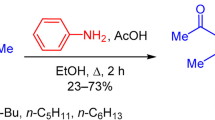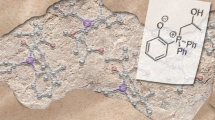Summary
-
1.
Ethoxyacetylene was reacted with 2-nitroethanol, 2,2,2-trinitroethanol and 2,2-dinitropropanediol in the presence of hydrogen chloride and the corresponding acetates were obtained.
-
2.
The theory was expressed that the chlorine atom in Β -nitrochloroalkanes in less labile than the chlorine atom in the corresponding unsubstituted aliphatic chloroparaffins.
Similar content being viewed by others
Literature cited
A. E. Favorskii and M. N. Shchukina, Zhur. Obshchei Khim.15, 394 (1945).
Th. R. Rix and J. F. Arens, Koninkl. Ned. Akad. Wetenschap. Proc.56B, 368–371 (1953); C. A.49, 2300b (1955).
I. L. Knunyants, Problems in Chemical Kinetics, Catalysis and Reactivity [In Russian] (Moscow, 1955) p. 716.
N. S. Marans and R. P. Zelinski, J. Amer. Chem. Soc.72, 5329 (1950).




